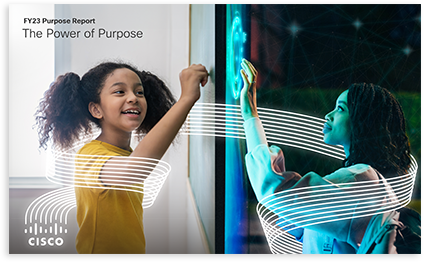Welcome to the Cisco
Purpose Reporting Hub
This site provides information and data related to our Purpose initiatives, performance, and policies.
Cisco's Purpose is to Power an Inclusive Future for All. Our FY24 Purpose Report summarizes how we combine our technology, people, and broader networks to address society's greatest challenges. The report describes our commitments, goals, progress, and impact for the topics that are significant to advancing Cisco’s Purpose and are important for our stakeholders. This Purpose Reporting Hub includes in-depth information on reporting topics.
FY24 highlights
40 years of impact We leverage our technology, people, and broader networks to address society’s greatest challenges
US$556M in cash and in-kind contributions provided by Cisco and the Cisco Foundation
720,000 employee volunteer hours
86% of employees participated to drive community impact
#1 Best Company to Work For in 16 countries, according to Fortune and Great Place to Work
40 Communities Announcing our next big ambition: over the next 10 years, we plan to engage, support, and invest in 40 communities around the globe
1600 Country Digital Acceleration projects in 50 countries since 2015
US$35M approved to fund climate solutions through the Cisco Foundation since FY21
of electricity for Cisco facilities came from renewable sources
96% of new Cisco products and packaging incorporate Circular Design Principles
4.7M students reached through Cisco Networking Academy
